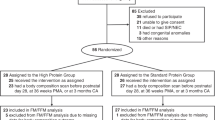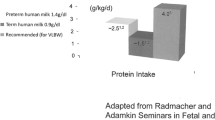Abstract
Objective:
The aim of this study was to compare the actual nutrient intakes observed in a previously reported study with assumed nutrient intakes based on the customary assumptions about the composition of human milk.
Study Design:
Fortified human milk is assumed to provide adequate amounts of nutrients for premature infants. This assumption holds if milk has the composition of milk expressed by mothers of premature infants during weeks 2 to 3 of lactation. The assumption does not necessarily hold for milk expressed after 2 to 3 weeks lactation. It also does not hold for donor milk, which is typically provided by mothers of term infants. The size of the disparity between assumed and actual nutrient intakes is not known. Actual nutrient intakes were available for 32 preterm infants participating in the study. Assumed nutrient intakes were calculated for these infants by substituting assumed nutrient concentrations for observed nutrient concentrations. Data were compared separately for each of the 3 study weeks.
Result:
Actual protein intakes were significantly and consistently lower than assumed protein intakes during each study week. The differences in mean intakes were large, ranging from 0.5 to 0.8 g kg−1 per day. Differences in energy intake were small and not consistently significant.
Conclusion:
Actual intakes of protein by preterm infants fed fortified human milk are substantially lower than assumed intakes. The discrepancy may in part explain why preterm infants frequently show postnatal growth failure.
This is a preview of subscription content, access via your institution
Access options
Subscribe to this journal
Receive 12 print issues and online access
$259.00 per year
only $21.58 per issue
Buy this article
- Purchase on Springer Link
- Instant access to full article PDF
Prices may be subject to local taxes which are calculated during checkout
Similar content being viewed by others
References
Blaymore Bier J, Oliver T, Ferguson A, Vohr BR . Human milk reduces outpatient upper respiratory symptoms in premature infants during their first year of life. J Perinatol 2002; 22: 354–359.
Hylander MA, Strobino DM, Dhanirreddy R . Human milk feedings and infection among VLBW infants. Pediatrics 1998; 102 (3): E8 www.pediatrics.org/cgi/content/full/102/3/e38.
Rønnestad A, Abrahamsen TG, Medbø S, Reigsatd H, Lossius K, Kaaresen PI et al. Late-onset septicemia in a Norwegian national cohort of extremely premature infants receiving very early full human milk feeding. Pediatrics 2005; 115: e269–e276.
Lucas A, Cole TJ . Breast milk and neonatal necrotising enterocolitis. Lancet 1990; 336: 1519–1523.
Sisk PM, Lovelady CA, Dillard RG, Gruber KJ, O'Shea TM . Early human milk feeding is associated with a lower risk of necrotizing enterocolitis in very low birth weight infants. J Perinatol 2007; 27: 428–433.
Quigley MA, Henderson G, Anthony MY, McGuire W . Formula milk versus donor breast milk for feeding preterm or low birth weight infants. Cochrane Database Syst Rev 2007; 17 (4): CD002971.
Henderson G, Anthony MY, McGuire W . Formula milk versus maternal breast milk for feeding preterm or low birth weight infants. Cochrane Database Syst Rev 2007; 17 (4): CD002972.
Anderson JW, Johnstone BM, Remley DT . Breast-feeding and cognitive development: a meta-analysis. Am J Clin Nutr 1999; 70: 525–535.
Bier JA, Oliver T, Ferguson AE, Vohr BR . Human milk improves cognitive and motor development of premature infants during infancy. J Hum Lact 2002; 18: 361–367.
Feldman R, Eidelman AI . Direct and indirect effects of breast-milk on the neurobehavioral and cognitive development of premature infants. Dev Psychobiol 2003; 43: 109–119.
Lucas A, Morley R, Cole TJ, Gore SM . A randomised multicentre study of human milk versus formula and later development in preterm infants. Arch Dis Child 1994; 70: F141–F146.
Vohr BR, Poindexter BB, Dusick AM, McKinley LT, Wright LL, Langer JC et al. Beneficial effects of breast milk in the neonatal intensive care unit on the developmental outcomes of extremely birth weight infants at 18 months of age. Pediatrics 2006; 118: e115–e123.
Ziegler EE . Breast-milk fortification. Acta Paediatr 2001; 90: 720–723.
Kuschel CA, Harding J . Multicomponent fortified human milk for promoting growth in preterm infants. Cochrane Database Syst Rev 2004, Cochrane Library. 2004; 1: CD000343.
Lemons JA, Moye L, Hall D, Simmons M . Differences in the composition of preterm and term human milk during early lactation. Pediatr Res 1982; 16: 113–117.
Polberger S, Raiha NCR, Juvonen P, Moro GE, Minoli I, Warm A . Individualized protein fortification of human milk for preterm infants: comparison of ultrafiltrated human milk protein and a bovine whey fortifier. J Pediatr Gastroenterol Nutr 1999; 29: 332–338.
Michaelsen KF, Skafte L, Badsberg JH, Jørgensen M . Variation in macronutrients in human bank milk: influencing factors and implications for human milk banking. J Pediatr Gastroenterol Nutr 1990; 11: 229–239.
Arslanoglu S, Moro GE, Ziegler EE . Adjustable fortification of human milk fed to preterm infants: does it make a difference? J Perinatol 2006; 26 (10): 614–621.
Gross SJ, Geller J, Tomarelli RM . Composition of breast milk from mothers of preterm infants. Pediatrics 1981; 68: 490–493.
Weber A, Loui A, Jochum F, Bührer C, Obladen M . Breast milk from mothers of very low birth weight infants: variability in fat and protein content. Acta Paediatr 2001; 90: 772–775.
Carlson SJ, Ziegler EE . Nutrient intakes and growth of very low birth weight infants. J Perinatol 1998; 18: 252–258.
Olsen IE, Richardson DK, Schmid CH, Ausman LM, Dwyer JT . Intersite differences in weight growth velocity of extremely premature infants. Pediatrics 2002; 110: 1125–1132.
Embleton NE, Pang N, Cooke RJ . Postnatal malnutrition and growth retardation: an inevitable consequence of current recommendations in preterm infants? Pediatrics 2003; 107: 270–273.
Ehrenkranz RA, Dusick AM, Vohr BR, Wright LL, Wrage LA, Poole WK . Growth in the neonatal intensive care unit influences neurodevelopmental and growth outcomes of extremely low birth weight infants. Pediatrics 2006; 117: 1253–1261.
Kashyap S, Schulze KF, Ramakrishnan R, Dell RB, Heird WC . Evaluation of a mathematical model for predicting the relationship between protein and energy intakes of low-birth-weight infants and the rate and composition of weight gain. Pediatr Res 1994; 35 (6): 704–712.
Author information
Authors and Affiliations
Corresponding author
Rights and permissions
About this article
Cite this article
Arslanoglu, S., Moro, G. & Ziegler, E. Preterm infants fed fortified human milk receive less protein than they need. J Perinatol 29, 489–492 (2009). https://doi.org/10.1038/jp.2009.50
Received:
Revised:
Accepted:
Published:
Issue Date:
DOI: https://doi.org/10.1038/jp.2009.50
Keywords
This article is cited by
-
Influence of maternal and perinatal factors on macronutrient content of very preterm human milk during the first weeks after birth
Journal of Perinatology (2023)
-
Use of human milk and fortification in the NICU
Journal of Perinatology (2023)
-
Body composition of extremely preterm infants fed protein-enriched, fortified milk: a randomized trial
Pediatric Research (2022)
-
Effect of increased enteral protein intake on plasma and urinary urea concentrations in preterm infants born at < 32 weeks gestation and < 1500 g birth weight enrolled in a randomized controlled trial – a secondary analysis
BMC Pediatrics (2018)
-
The effects of human milk fortification on nutrients and milk properties
Journal of Perinatology (2017)



